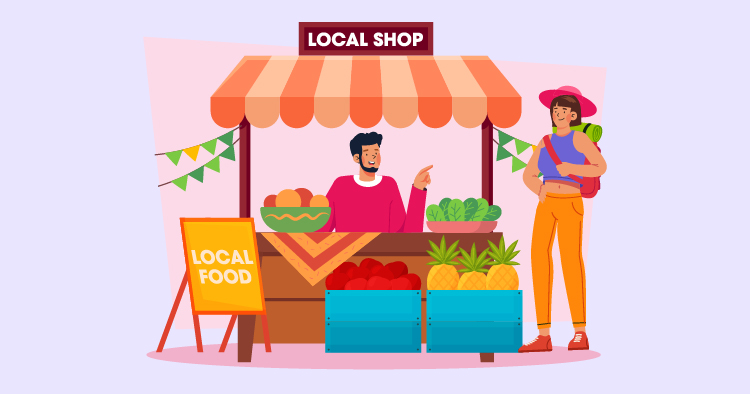Local e-commerce is becoming a popular way for businesses to meet the rising demand for online shopping while keeping a local touch. This approach lets customers enjoy the ease of online shopping while supporting their local economy—all from home. If you’re a small business owner or an entrepreneur, understanding local e-commerce is crucial to maximizing this opportunity. This article will explore local e-commerce, its advantages, and how you can ensure your business stands out in this market.
What Is Local Ecommerce?
Local e-commerce allows businesses to sell their products or services online, focusing on nearby customers. This approach mainly benefits companies with physical locations that want to connect with the local community. For instance, a neighborhood bakery might enable customers to place orders online, pick them up in person, or deliver them locally.
This model is becoming increasingly popular for several reasons. It can significantly reduce shipping costs and shorten delivery times, a big plus for the business and the customer. It’s also an excellent way for smaller firms to stay competitive against the big players in the online market. By emphasizing local SEO and fostering relationships within the community, these businesses can become well-known and preferred choices for local shoppers.
How to Build a Local Ecommerce Website
When you’re ready to take your local business online, there are a few key steps. Start with market research to understand what local customers are looking for and how you can meet their needs. Tools like Google Analytics can shed light on local search trends, while surveys can help gauge customer interest.
Then, think about the features that will make your website stand out. Do you want to offer the convenience of local delivery, the immediacy of in-store pickup, or both? These decisions will guide the design and functionality of your site.
Next comes the development phase. You might work with a professional web developer or go the DIY route with an e-commerce platform that simplifies the process. Either way, ensure your website is easy to navigate, looks great on all devices, and works without a hitch.
Before officially opening your virtual doors, put your website through its paces to ensure everything runs smoothly. A seamless and enjoyable customer experience encourages repeat business and builds a loyal local customer base.
Choosing the Right Platform for Your Local Ecommerce Website
Selecting an ecommerce platform for your local business can be a pivotal decision. It’s like picking the location for a physical store: You want a spot that’s cost-effective, accessible, and scalable. Here’s how to weigh your options.
Struggling with Digital marketing? Book Your Free Strategy Session!
- 30-Minutes Session
- Expert Insights
- Data-Driven approach
- Optimized Strategies for Your Goals
Select one of over 500 designs and establish your online presence.
- Free Web Hosting
- Fully Managed Solutions
- Scalable Websites
- No Hidden Cost
Running Costs
When looking at ecommerce platforms, consider how much you can afford to spend. Like paying rent for a storefront, you’ll have to pay to keep your online store up and running. Some platforms charge a flat monthly fee, which can be easier to budget. Others might take a cut of every sale you make, which means your costs go up as you sell more.
Digging into the details of what you’re paying for is essential. Some platforms include web hosting, security, and customer support fees, while others might charge extra. Remember to factor in the cost of any additional features or tools you might need. By understanding all the possible expenses, you’ll avoid nasty surprises and pick a platform that fits your budget.
Integrations
Like a store needs a cash register and inventory shelves, your ecommerce site needs specific tools to run smoothly. Payment gateways are necessary for processing transactions, while Customer Relationship Management (CRM) systems help you keep track of your customers and their orders. Inventory management is another critical tool that enables you to monitor what’s in stock.
Before settling on a platform, list all the tools and services you’ll need. Check if the platform supports them or has its versions. Some platforms make it super easy to plug in these tools, while others might require technical know-how. The goal is to choose a platform that either comes with everything you need or makes it simple to add them on. This way, you can ensure your online store operates without a hitch and provides a good experience for your customers.
Themes and User Experience
When picking a platform for your website, visual appeal is crucial. You want to grab attention and keep visitors on your site. Look for a service that provides a variety of themes that you can tailor to your brand’s style. These themes should also be mobile-friendly, meaning they look good and work well on phones and tablets. User experience, or how people interact with your site, is just as necessary. A smooth and intuitive experience can lead to more sales, so consider what your customers need and how they browse your site.
Speed and Scalability
Nobody likes a slow website. It’s frustrating and can drive people to leave before seeing your offer. So, speed should be on your list when choosing where to build your online presence. But it’s not just about being fast now—it’s about staying tight as your business grows. You need a platform to keep up, whether adding new products, getting more visitors, or processing more orders. This adaptability is known as scalability, and it’s essential for a smooth operation as your business expands.
Platform Security
It’s crucial to keep your customers’ data safe. When choosing an online platform, look for one with solid security measures. This includes SSL certificates, which encrypt data to keep it secure during transmission. Also, the platform should conduct regular security audits to identify and fix any vulnerabilities. Using a platform with these security features will gain your customers’ trust and protect you from legal problems.
Mobile-friendliness
Nowadays, many people use their smartphones to shop. That’s why having a website that works well on mobile devices is essential. Make sure the platform you choose supports responsive design. This means your website will look good and be easy to use, whether someone is on a phone, tablet, or computer. A mobile-friendly site is vital for providing a good shopping experience for all your customers, no matter how they access your site.
SEO-friendliness
When running an e-commerce site, especially if you have a local business, you need to be familiar with search engines. Why? Because good SEO helps people find you online. Look for a platform that makes tweaking things like meta tags easy. These bits of text tell search engines what your pages are about. You also want a platform that gives you clean, simple web addresses (URLs) and lets you use Schema markup. Schema is like a secret code that gives search engines more details about your content, which can help show up in local search results. When your site is accessible for search engines to understand, it’s more likely that people in your area will find you when they’re searching for what you sell.
Select one of over 500 designs and establish your online presence.
- Free Web Hosting
- Fully Managed Solutions
- Scalable Websites
- No Hidden Cost
Ecommerce Platform with Your Preferred Hosting
Choosing an ecommerce platform that allows you to select your hosting can give you a lot of flexibility. This means you can pick the hosting service that meets your specific requirements, such as budget, traffic capacity, and server location. A platform like WooCommerce, which integrates with WordPress, is a popular choice for those who want the freedom to tailor their online store. While it offers a wide range of customization options, it’s worth noting that it might take some time to learn how to use all of its features effectively. Additionally, you’ll need to manage updates and security measures yourself, which is something to consider if you’re not tech-savvy.
How to Drive Traffic to Your Local Ecommerce Website
To get more people to visit your local ecommerce site, it’s essential to make sure they can find you easily when they search online. Optimizing your site for local search engines is a great start. This means using keywords that people in your area might use when looking for products like yours. Setting up a Google My Business account can also help your store appear in local search results and on maps.
Social media is another powerful tool for reaching local shoppers. For example, on Facebook, you can use advertising features to show your ads to people in a specific geographic area. This can help you target potential customers who are nearby.
Email marketing can also be very effective. By sending relevant and engaging emails to your local customer base, you can keep them updated on what’s new in your store and any special offers you might have.
Collaborating with other local businesses can also be beneficial. By running promotions together or hosting joint events, you can tap into each other’s customer bases. This can be a great way to get more local people interested in what you have to offer.
Making Your Local Ecommerce Website a Success
Local e-commerce combines the ease of online shopping with the charm of local businesses. To make your ecommerce website successful, it’s essential to choose a user-friendly platform, focus on creating a great shopping experience, and optimize for local search engine rankings.
Understanding the unique flavor of your community is critical. Pay attention to what local customers want and need. This approach helps you go beyond just another online shop; you become a valued part of the local scene.
Building a successful local ecommerce business takes time and dedication. By implementing intelligent strategies and consistently working to improve, your ecommerce store can grow to be a favorite shopping spot within your community. Here’s to your success and the joy of selling locally!
Final Thoughts
Starting a local e-commerce business can change the game for small businesses aiming to broaden their customer base and engage with them in a new way. By offering unique local items, giving personalized service, and tapping into local networks, you can build a solid online presence to which your community feels connected. As technology moves forward, being flexible and keeping your customers at the forefront of your business will be vital for your success. Stepping into local e-commerce isn’t just about selling things—it’s about nurturing relationships and boosting the local economy. Your local e-commerce venture can genuinely thrive with a solid plan and commitment.



